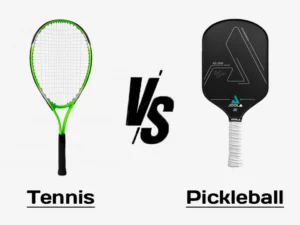 Pickleball and tennis, both racket sports, have captured the hearts of millions of athletes worldwide. While they share some similarities, they are fundamentally different in gameplay, rules, and equipment. In this article, we’ll dissect the distinctions between pickleball and tennis, allowing enthusiasts of both sports to appreciate the unique aspects that make each one an exhilarating experience.
Pickleball and tennis, both racket sports, have captured the hearts of millions of athletes worldwide. While they share some similarities, they are fundamentally different in gameplay, rules, and equipment. In this article, we’ll dissect the distinctions between pickleball and tennis, allowing enthusiasts of both sports to appreciate the unique aspects that make each one an exhilarating experience.
The Court: A Tale of Two Sizes
Let’s start with the most obvious difference: the size of the plate. Tennis courts are much larger than pickleball courts. A standard singles tennis court is 78 feet long by 27 feet wide, while a pickleball court is only 44 feet long by 20 feet wide. The difference in size directly affects game dynamics.
Equipment: Rackets and Balls
Rackets in both sports differ in size and weight. Tennis rackets are larger and heavier, often weighing between 9 and 12 ounces, with a head size of 85 to 135 square inches. Pickleball paddles, on the other hand, are more compact and lighter, weighing 6 to 9 ounces and measuring about 8 to 10 inches in width.
The balls used in the two sports are also distinct. Tennis balls are larger and have a harder, felt-covered surface. In contrast, pickleballs are smaller and have a series of holes, much like a wiffle ball, making them lighter and less bouncy.
Serving: The Serve’s the Thing
In tennis, the serve is a key element of the game. The server must stand behind the baseline and hit the ball diagonally into the opponent’s tee box. Serving is subject to special rules regarding the server’s stance and foot position.
In pickleball, the serve is underhand, and it must be hit below the server’s waist. The server must serve diagonally and allow for a double bounce before the opposing side can return the serve. This double-bounce rule makes pickleball more accessible to players of all skill levels and ensures longer rallies.
Scoring: Love or 15-0?
Tennis employs a scoring system that often confuses newcomers. The game consists of points (15, 30, 40), and the first player to score four points wins the game, provided they have a two-point advantage. If both players reach 40 points, it’s referred to as “deuce,” and one player must win by two consecutive points to secure the game. Tennis matches are usually best-of-three sets, with each set requiring six games to win.
In pickleball, scoring is straightforward. Games are played to 11 points, and points can be won only by the serving side. If the score reaches 10-10, a team must win by two points. Pickleball matches are often best-of-three games, with each game requiring 11 points to win.
Gameplay: Power vs. Precision
Tennis is known for its power and speed. Players must cover a large court and use powerful strokes to hit the ball over the net and past their opponent. The longer rallies in tennis often showcase impressive athleticism, agility, and endurance.
Pickleball, in contrast, emphasizes precision and placement over power. The smaller court and slower ball speed encourage strategy, finesse, and quick reflexes. Pickleball rallies are typically shorter, demanding players to focus on accurate placement and well-timed shots.
The Net: Height Matters
The net height is another noticeable difference. In tennis, the net stands at 3 feet in the center and 3 feet 6 inches at the posts. In pickleball, the net is considerably lower, measuring just 34 inches at the center and 36 inches at the sides. The lower net in pickleball allows for more accessible volleys and adds an exciting dimension to the game.
The I&G Pickleball Company Advantage
While tennis and pickleball are unique in their own right, both sports share a common need for high-quality equipment. I&G Pickleball Company is your go-to source for top-notch pickleball gear, from premium paddles to accessories.
Whether you’re a tennis enthusiast curious about pickleball or a dedicated pickleball player looking to up your game, I&G Pickleball Company has you covered. Their paddles are engineered using cutting-edge technology, providing players with the perfect blend of power, control, and durability. Explore their product range to discover how they are elevating the pickleball experience for players of all levels.
In conclusion, despite their similarities to racket sports, pickleball and tennis offer distinctive playing experiences. Differences in court size, equipment, serving rules, scoring, and gameplay dynamics make each sport a unique and exciting endeavor. Whether you prefer the power and endurance of tennis or the precision and strategy of pickleball, both sports have a place in the hearts of athletes worldwide. Thanks to companies like I&G Pickleball, players can access top-tier equipment that enhances their performance and enjoyment in the sport they choose.
